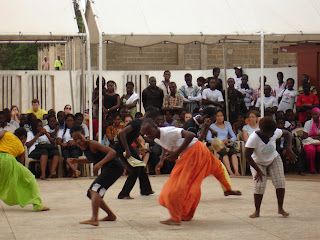
Ghana has had a long history with African America. Even though Liberia and Sierra Leone accepted ex-slaves during the 19th century repatriation movement, those experiments have had a checkered history with questionable success. Our own W.E.B. Du Bois, one of the key founders of the NAACP and author of one of the first worldwide bestsellers by a black author, "The Souls of Black Folk" (1903), came here at the end of his life and is buried in Accra. He was invited with open arms by President Kwame Nkrumah, the first president of independent Ghana, after the U.S. restored Du Bois's passport during the McCarthy Era red scare. The opening picture shows the entrance to the W.E.B. DuBois Center, which is directed by Dr. Anne Adams, former professor at Cornel University.

Inside the Centre, celebrating Du Bois's 140th Anniversary
It is also one of the first tourist sites that Gene and I visited on arriving in Ghana. We wanted to pay homage to the legacy of Dr. Du Bois. The museum contains rare photos of Du Bois and his wife Shirley in Ghana. One can see that he was treated royally and visited and honored by Nkrumah frequently. In fact the entire Centre was the Du Bois's home that Nkrumah gave them soon after their arrival. Du Bois's office has his desk and library in it with original copies of the "Souls of Black Folk," and one of his novels, "Darkwater." It was an awesome feeling to see original artifacts of this great man about whom I have studied and about whom I currently teach at UC Davis.

Exhibited Photo of Nkrumah and W.E.B. and Shirley Du Bois at a State function

Photo of Nkrumah Visiting DuBois on his 95th Birthday, the year of his passing
The highlight of our visit to the Du Bois Centre was seeing his tomb and his wife's cremation urn side my side in the mausoleum. Yes, Du Bois died and remains in Ghana.

In fact, as fate would have it, he passed away at 95 years old on the morning of the March on Washington, August 28, 1963. I said an ancestor prayer in the mausoleum and thanked him for his many contributions to our people and world culture. Belinda, the docent, took pictures of Gene and I in Ghanaian stools that line the room.

Halifu in Du Bois Mauseleum

Gene in Du Bois Mauseluem
I left feeling reverence and knew my purpose: like Du Bois, bridging Africa and African America---letting both sides understand their connections in a deeper way. Mine is through culture and the arts. Du Bois’s was through literature and political organizing. Yes, he was also one of the architects of the Pan African Congress that happened between 1919-1945. In fact, the latter world meetings was where the young Kwame Nkrumah first met “the old man.”

Nkrumah, had part of his university education in the United States Lincoln University, the first degree-granting historically black university. One can’t help but feel that his time at Lincoln gave him a particular sensitivity to the plight of African Americans. Perhaps that was one of the reasons why during the Civil Rights Movement he appeared before the UN to lobby for the political situation of African Americans being considered a world human rights issue. Like Du Bois be believed in Pan Africanism, and was one of the key African leaders during the beginning of the African Independence Movement (Ghana was the first independent country in 1957) to promote and establish the Organization of African Unity (OAU). Although history has painted him as a liberator that turned into Ghana's autocratic first President, leading to a coup against him in 1966, Nkrumah is still revered here and has a huge memorial to him in downtown Accra, with his own mausoleum, where his remains rest, which Gene and I also visited.

Gene at Nkrumah Memorial
All of these historic facts linking Nkrumah and Du Bois testify to the long-connections between Ghanaians and African Americans. This relationship set the tone for many American blacks who have moved here, established businesses, started families, and have become citizens.






















